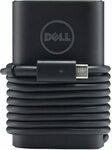38% off the usual price and IMO a good price for a 65W USB-C charger from a respected brand. Can be used to charge any kind of USB-C device and comes with 2 years warranty.
Not sure how it compares to Ankers quality, but seems pretty hard to beat value wise.
Please note: The USB-C cable is not removable from the brick.




https://www.mwave.com.au/product/dell-e5-65w-usb-typec-ac-ad…
Cheaper at Mwave with pickup options or $6 shipping.